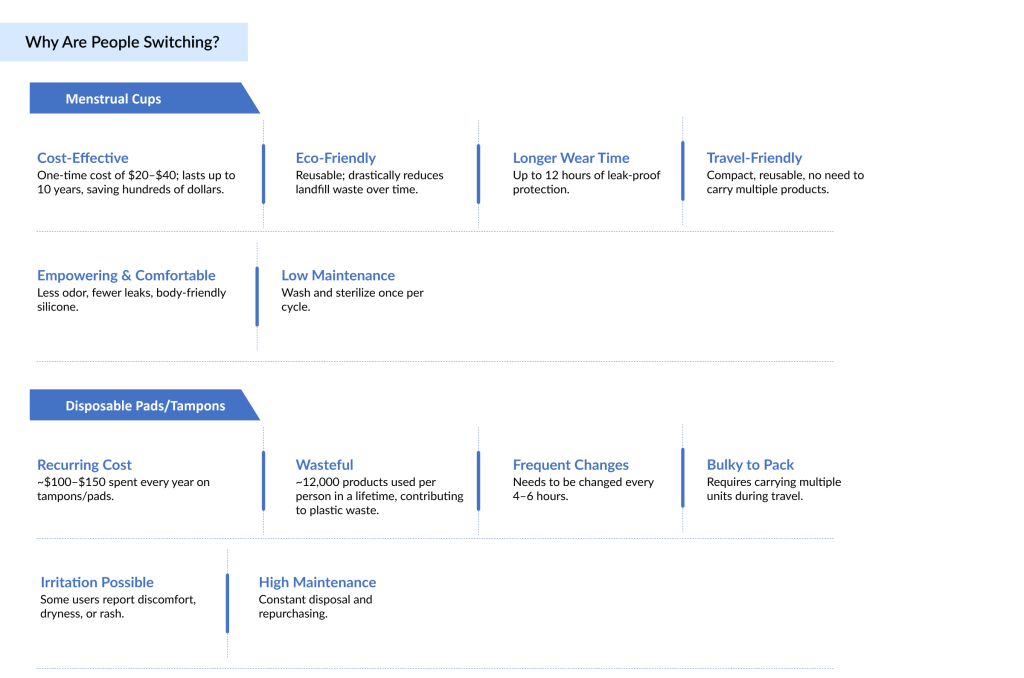The Rise of Menstrual Cups: Revolutionizing Healthcare and Sustainability
Jul 09, 2025
Table of Contents
Menstrual cups, often referred to as a cup for menstruation, have emerged as a transformative option in feminine hygiene, gaining traction in the menstrual cups market worldwide. But what is a menstruation cup? It’s a reusable, bell-shaped device, typically made from silicone cups for menstruation, crafted from medical-grade silicone, designed to collect menstrual fluid rather than absorb it like traditional pads or tampons. Unlike disposable products, these cups can be worn for up to 12 hours, emptied, rinsed, and reused, offering an eco-friendly and cost-effective alternative.
The rise in popularity of cups for menstruation stems from the growing awareness of sustainability and personal health. Available at major retailers like menstruation cup Walgreens, these cups resonate strongly with environmentally conscious consumers aiming to minimize their ecological footprint, every year, billions of disposable menstrual products end up in landfills, making menstrual cups a sustainable and impactful alternative. Additionally, questions like “Are menstruation cups safe?” are increasingly addressed by experts, who confirm that high-quality silicone cups pose minimal health risks when used correctly, even alleviating concerns like menstruation cup cramps for many users. Innovations such as disposable menstruation cups further cater to those hesitant about long-term reusability, broadening the appeal.
Downloads
Click Here To Get the Article in PDF
Recent Articles
This shift reflects a cultural move toward normalizing menstruation and empowering users with sustainable choices. As the menstrual cups market continues to grow, menstrual cups are redefining period care with a focus on health, convenience, and environmental responsibility.

Market Trends and Growth
The menstrual cups market is witnessing robust growth, driven by rising demand for sustainable and health-conscious menstrual products. Valued at USD 821 million in 2021, the global market is projected to reach USD 1,221.59 million by 2032, growing at a CAGR of 5.98% during the forecast period (2025–2032). Key drivers include the increasing prevalence of menstrual disorders such as Menorrhagia and Polycystic Ovarian Disease (PCOD), earlier onset of puberty, and growing awareness of menstrual hygiene. The widespread availability of menstruation cups through retail and online platforms has made cups for menstruation increasingly accessible, cementing their place in mainstream feminine hygiene.
North America dominates revenue generation in the global menstrual cups market, fueled by a large population of working women and college students, heightened consumer awareness, and frequent product innovations. Data from the Centers for Disease Control and Prevention (2020) indicates that 53% of U.S. women aged 15–44 reached menarche by age 12 between 2013–2017, highlighting a significant user base for cups for menstruation products. Additionally, the rising incidence of menstrual disorders, with 1 in 5 U.S. women experiencing heavy menstrual bleeding (CDC, 2021), drives demand for silicone cups for menstruation due to their superior blood-holding capacity compared to traditional pads or tampons.
The preference for menstruation cups among working women and students, who value their leak-proof design and longer wear time, is a major growth factor. According to the U.S. Bureau of Labor Statistics (2021), 57.4% of U.S. women are part of the labor force, representing a substantial market for convenient solutions like the menstruation cup. Innovations such as disposable menstruation cups and enhanced safety features address concerns like menstruation cup safety and menstruation cup cramps, further boosting adoption. As manufacturers prioritize product development and expand distribution channels, the menstrual cups market is set for sustained growth, particularly in regions with strong consumer education and market infrastructure.
Health and Safety Insights
Menstrual cups, particularly silicone cups for menstruation, are crafted from medical-grade silicone, a material widely regarded for its safety and biocompatibility in medical applications. Extensive research, including studies from the World Health Organization, confirms that these cups pose minimal health risks when used and maintained properly, offering a safe alternative to traditional menstrual products. Unlike tampons, menstruation cups reduce the risk of toxic shock syndrome, as they collect rather than absorb menstrual flow, avoiding prolonged contact with vaginal tissues.
A common concern among new users is menstruation cup cramps. For most, cramps are not caused by the cup itself but may result from improper sizing or insertion technique. Selecting the right cup size, based on factors like age, flow, and pelvic floor strength, can significantly improve comfort. For instance, smaller cups are often recommended for younger users or those with lighter flows, while larger cups suit heavier flows or post-childbirth users. Adjusting insertion depth and ensuring proper suction release can further minimize discomfort. User feedback suggests that with practice, many find cups menstruation more comfortable than tampons, as they adapt to the body’s natural shape.
Proper hygiene is key to safety. Regular cleaning with mild soap and water, and sterilizing the cup between cycles (e.g., boiling for 5–10 minutes), prevents infections. Disposable menstruation cups offer an alternative for those hesitant about reusable options, though they are less cost-effective and eco-friendly. By addressing these practical aspects, cups for menstruation users can confidently manage their menstrual health, supported by evidence affirming the safety and efficacy of these devices.
Consumer Benefits and Practical Tips
The cup for menstruation is revolutionizing menstrual care with its cost-effectiveness and sustainability. A single menstruation cup, typically crafted from durable silicone cups for menstruation, costs $20–$40 and can last up to 10 years with proper care. Compared to the $100–$150 spent annually on disposable pads or tampons, this offers significant savings. Environmentally, cups for menstruation reduce waste dramatically, unlike the estimated 12,000 disposable menstrual products used over a lifetime, a reusable cup has minimal landfill impact, aligning with global sustainability goals.
For first-time users, adopting a menstruation cup may feel intimidating, but practical guidance simplifies the process:
- Choosing the Right Cup: Select a size based on flow, age, and pelvic floor strength—smaller cups suit lighter flows or younger users, larger ones for heavier flows or post-childbirth.
- Insertion: Fold the cup using techniques like the C-fold or punch-down fold, insert it low in the vaginal canal, and ensure it opens fully for a leak-free suction seal.
- Removal: Pinch the base to release suction, gently pull out, and empty contents. Practice over a few cycles minimizes menstruation cup cramps for many users through proper positioning.
- Cleaning: Rinse with mild, unscented soap and water during use; sterilize by boiling for 5–10 minutes between cycles. Disposable menstruation cups are an option for convenience, though less eco-friendly.
These benefits make menstruation cups an empowering choice, offering up to 12 hours of leak-free wear and confidence for active lifestyles. By mastering these techniques, users can embrace a sustainable, budget-friendly solution that transforms period care.
Innovations and Market Opportunities
The menstrual cups market is experiencing dynamic growth, propelled by rising cases of menstrual disorders, increasing awareness of menstrual hygiene, and a global shift toward eco-friendly feminine hygiene solutions. Conditions like Menorrhagia, marked by heavy menstrual bleeding, and Polycystic Ovarian Disease (PCOD), associated with irregular periods and heavy flow, have increased demand for menstruation cups due to their ability to hold more blood than traditional pads or tampons and their reusable nature. According to World Bank 2022 data, approximately 500 million women lack access to menstrual products, creating a significant opportunity for cups menstruation. Organizations like UNICEF are driving educational initiatives to promote menstrual hygiene, further accelerating the adoption of the cup for menstruation in underserved regions.
Innovation is a cornerstone of this market’s expansion. Companies are introducing disposable menstruation cups for users prioritizing convenience, while silicone cups for menstruation are being refined with varied sizes, shapes, and materials to cater to diverse needs, addressing concerns like menstruation cup cramps through ergonomic designs. Emerging advancements, such as biodegradable cups and smart cups with flow-tracking technology, are enhancing user experience and aligning with sustainability trends. The environmental impact of disposable menstrual products, which contribute 150 kilograms of non-biodegradable waste per woman and take 800 years to decompose (World Bank 2022, WIPO 2020), underscores the appeal of menstruation cups as a sustainable alternative.
Key players like Redcliffe Hygiene Private Limited, The Keeper, Inc., Lena Cup, INTIMINA, Blossom Cup, Mooncup Ltd, PEPTONIC Medical, YUUKI Company s.r.o., Anigan, LadyCup, Me Luna GmbH, The Flex Company, Procter & Gamble, Diva International Inc., Saalt, and others are leveraging these trends through product innovation and strategic partnerships.
Market opportunities are further amplified by strategic efforts to expand access. Collaborations with NGOs and governments to distribute menstruation cups in low-access regions, combined with the growth of e-commerce platforms, are making these products more accessible. Despite challenges like competition from alternative products and rare allergic reactions to cup materials, the menstrual cups market remained resilient during COVID-19, with menstrual products classified as essential commodities, ensuring uninterrupted production and distribution. These factors, coupled with ongoing innovation, position the menstrual cups market for sustained growth through 2032, transforming menstrual care on a global scale.

Breaking Stigmas and Encouraging Adoption
The menstrual cups market is instrumental in transforming societal attitudes toward menstruation by fostering open dialogue and reducing longstanding taboos. Cultural stigmas often discourage individuals from exploring innovative period care options like the cup for menstruation, but educational campaigns by organizations such as UNICEF and advocacy on social media are changing this narrative. These efforts emphasize the safety, practicality, and environmental benefits of silicone cups for menstruation, addressing concerns like menstruation cup cramps by offering guidance on proper sizing and usage techniques to ensure comfort and reliability.
To drive adoption, lowering the barrier to entry is essential. Programs providing free samples, starter kits, or disposable menstruation cups make it easier for first-time users to try cup menstruation. Real-world success stories amplify this effort; students highlight the convenience of extended wear time, while professionals appreciate the leak-proof design for busy schedules. A 2023 survey by a leading menstrual health brand revealed that 85% of users felt more confident and comfortable after switching to menstruation cups. By sharing these experiences through online platforms, community workshops, and peer support networks, the menstrual cups market builds trust and encourages broader acceptance, paving the way for a more inclusive approach to menstrual health.
Conclusion
The menstrual cups market is redefining feminine hygiene by offering a sustainable, cost-effective, and health-conscious alternative to traditional menstrual products. These devices empower users with greater control over their menstrual care, providing comfort and convenience while aligning with global environmental priorities. The growing acceptance of menstrual cups reflects a broader cultural shift toward prioritizing wellness and sustainability, positioning them as a cornerstone of modern period care.
For consumers, the opportunity lies in embracing cups for menstruation to experience their practical benefits firsthand and contributing to a more open dialogue about menstruation. By trying a cup for menstruation and sharing their journeys, individuals can help normalize its use and inspire others. Industry stakeholders have a critical role in expanding access through innovative product designs, such as disposable menstruation cups or ergonomic silicone cups for menstruation, and by partnering with organizations to reach underserved communities. Together, these efforts can drive the menstrual cups market forward, ensuring that sustainable menstrual care becomes a global standard.

Downloads
Article in PDF



